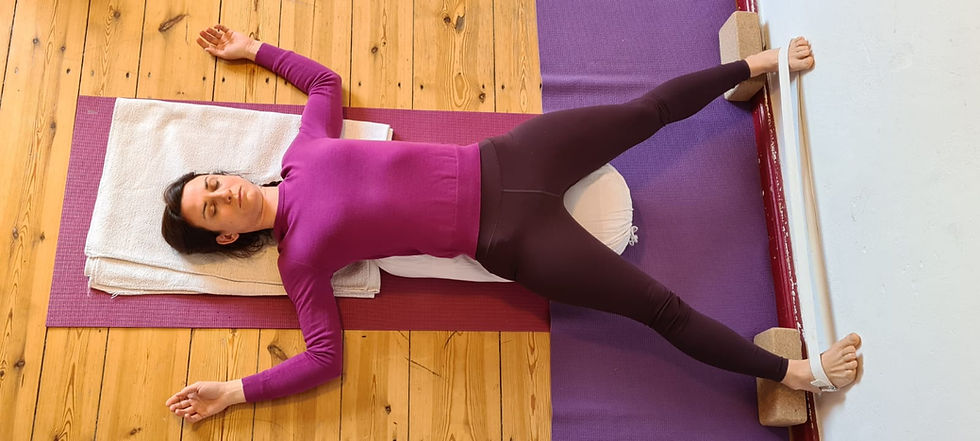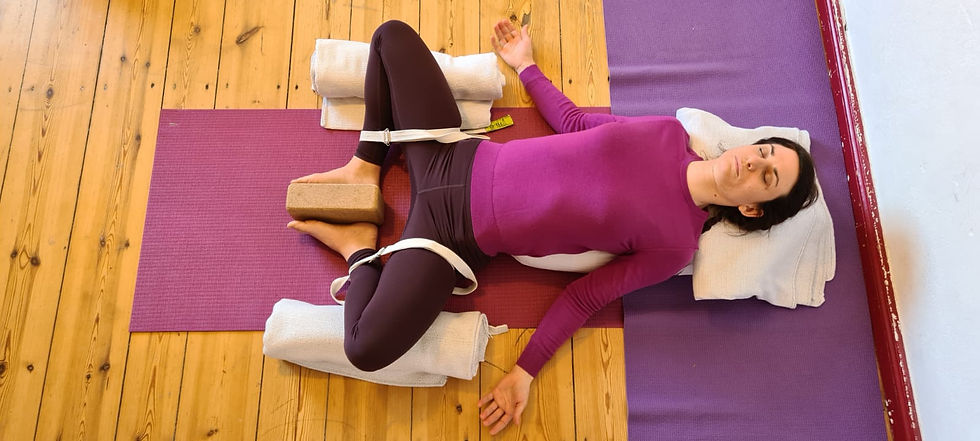Yoga for Women
- claudiyengar

- Aug 24, 2021
- 5 min read
Updated: Aug 25, 2021
A conversation with Chandra Baumgärtner, certified Iyengar yoga teacher and specialised in teaching yoga to women.
The differences could not be greater: At the beginning of the 20th century, yoga was practised almost exclusively by men in India and male bodybuilders in the West - 120 years later, women are the main practitioners of yoga worldwide (75%).
(Source: https://www.thegoodbody.com/yoga-statistics/)
The claim that yoga was originally conceived by men for men (-bodies) was countered in the early 1980s by experienced and long-time yoga practitioners such as Geeta Iyengar, Lois Steinberg and Bobby Clennel, among others, with the first publications and events on the topic of "yoga for women", "yoga in pregnancy", etc. Why it is important for a woman's physical and mental health to adapt her yoga practice is something I talked about with Chandra Baumgärtner, who has recently started offering her own class on this topic.

Claudia Lamas Cornejo: Dear Chandra, why should yoga be taught differently for women than for men?
Chandra Baumgärtner:
If we look at a woman's body and a man's body from the outside, we notice many differences: Muscle structures are different, joints, ligaments, tendons and bone density are different in women than in men. Much of this is related to the fact that women have or have had a menstrual cycle and are therefore subject to greater hormonal fluctuations for much of their lives. Let's not kid ourselves, they are two different bodies!
They are also subject to different stresses and strains due to social, historical, cultural and societal influences and developments. In no other practical school do we deal with the body as much as in yoga. Therefore, yoga classes should also address these fundamental differences, which ultimately also affect the psyche and what is often referred to as the "mind" in yoga.
CLC: Some women don't even know that they shouldn't do yoga inversions during their menstruation, for example, because this impedes the natural blood flow and can lead to cramps in the lower abdomen and other cycle problems...
CB: Yes, on the one hand there is a lack of the necessary knowledge, on the other hand it is drummed into us women from all corners and ends that we can and should do everything exactly the same way as men. In all areas of life. Look at some of the posts on Instagram, I recently saw a very pregnant yoga practitioner in the plank, her baby bump almost on the ground. Who is that supposed to be good for? ...and what is it supposed to say to us? Maybe: "Look here: I'm about to give birth to my child and I can still do push-ups...???"

Photo: Setu Bandha with pad, legs supported.
CLC: Briefly back to your beginnings in yoga, what was that like?
CB: As a child I was very fond of movement and had a hard time concentrating on anything while sitting in style. My mother practised Hatha Yoga at home and tried to get me interested in it so that I could calm down. But I found that rather boring and off-putting. When I was 21 years old, a friend took me to Asthanga yoga and I was immediately totally inspired by the dynamics and flow of this style. Unfortunately, the teacher at the time made no distinction between me, a very flexible student, and, for example, my friend, who was very stiff. After two years I developed massive lower back pain and knee problems, and tore both my menisci, so I thought yoga was bad for my very flexible body. After a two-year break, I happened to meet a teacher in Ibiza, Augustina, who was a long-time Iyengar yoga teacher herself, even though she always said of herself that she didn't teach Iyengar yoga. She had a group of women between 20-35 years old and in her classes, in which she playfully integrated many tools, I experienced for the first time how yoga asanas are taught, starting from the respective physical or psychological state of the student.
CLC: How did you end up in Iyengar Yoga?
CB: Augustina left Ibiza at some point and when I was looking for a new teacher I ended up with Miguel Angel, a student of Faeq Biria. Miguel taught almost only standing postures for beginners and intermediates, so I first really learned to pull up and use my kneecaps and thigh muscles. The very structured, clear approach in Miguel's classes, typical of the Iyengar yoga style, helped me to focus and be more physically and emotionally stable in the postures.
CLC: In Iyengar Yoga, not only since the publication of Geet Iyengar's book "Yoga for Women", great attention has been paid to practising according to the cycle. In the training, for example, the special menstruation programme and, since the new level classification, also the programme for pregnant students is an important part of the basic training. Have you worked with these publications?
CH: Yes, I practiced with this great book by Geeta Iyengar, "A Gem for Women" during my pregnancy. At that time I was living in Venezuela and didn't have a teacher nearby. The book was a good help, even though I have to say in retrospect: The book is not suitable for beginners. There was a lot I didn't understand at the time and I only practised what I felt confident with.
Today, non-fiction books on this subject, for example by Lois Steinberg or Bobby Clennell, have a simpler structure. If a suggested posture cannot be adopted, alternatives or variations using aids are included. Both of these authors were students of Geeta Iyengar for decades, so we have indirect access to their knowledge.

Photo: Supta Baddha Konasana supported.
CLC: What is your goal with your approach and your course "Yoga for Women"?
CB: It is important to me that each student learns to listen to her body and not simply bounce through a prescribed programme. Training the perception of one's own body protects one from blindly following a teacher or a method.
CLC: Abhijata Iyengar once described what you are describing as "sensitivity training". It starts with honest self-study, called svadjaja....
CB: Yes, exactly, and I want to support my students in recognising that for themselves, because sometimes a woman doesn't take blocks because she wonders: "But last week I could still get down to the floor, why not today?" - Because the cycle is a week further on and the hormonal situation has already changed, making muscles and joints stiffer.
It is important to me to integrate all yoga practitioners, whether pregnant or with menopause problems, into the classes and to show them a way to practise optimally for themselves at every moment of their cycle. This includes learning which tools to use and how to use them, and how to approach arm balances as a woman, for example, or other asanas that are easy for men because of their different muscle structure.
CLC: Are men also welcome here?
CB: Absolutely! I encourage newly qualified teachers to experience such an exercise sequence from my class on their own bodies. We can only pass on what we have practised and explored ourselves. Of course, after a sequence for pregnant women, a man will never feel the same as a pregnant woman, but hopefully he will understand better what a pregnant yoga practitioner needs and why.
Claudia Lamas Cornejo: Thank you very much for the interview!
Chandra Baumgärtner: Thank you!

Claudia Lamas Cornejo is a self-employed PR manager, Iyengar Yoga practitioner and teacher.
Her project "Iyengar Yoga Blog" aims to shed light on topics related to the study and practice of yoga, to give practice tips and to let different voices of the Iyengar Yoga community have their say:



